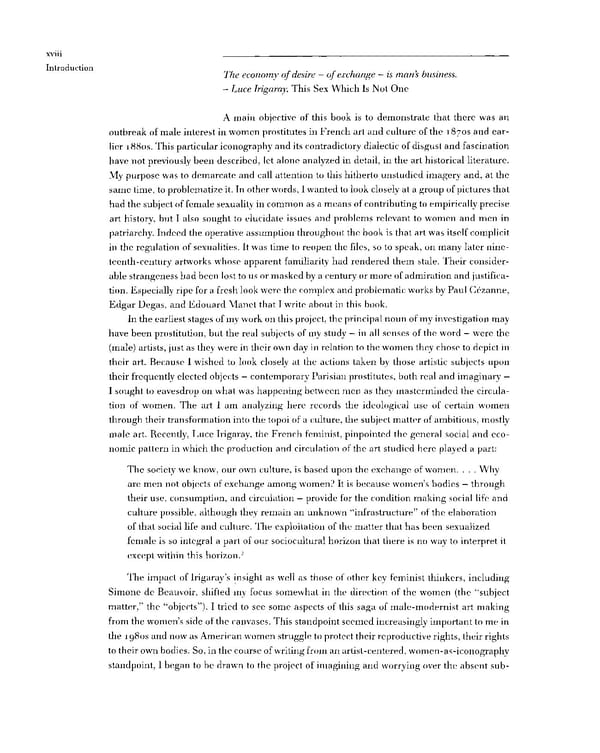XV111 Introduction The economy of desire - of exchange — is mans business. - Luce Irigaray, This Sex Which Is Not One A main objective of this book is to demonstrate that there was an outbreak of male interest in women prostitutes in French art and culture of the 18708 and ear- lier i88os. This particular iconography and its contradictory dialectic of disgust and fascination have not previously been described, let alone analyzed in detail, in the art historical literature. My purpose was to demarcate and call attention to this hitherto unstudied imagery and, at the same time, to problematize it. In other words, I wanted to look closely at a group of pictures that had the subject of female sexuality in common as a means of contributing to empirically precise art history, but I also sought to elucidate issues and problems relevant to women and men in patriarchy. Indeed the operative assumption throughout the book is that art was itself complicit in the regulation of sexualities. It was time to reopen the files, so to speak, on many later nine- teenth-century artworks whose apparent familiarity had rendered them stale. Their consider- able strangeness had been lost to us or masked by a century or more of admiration and justifica- tion. Especially ripe for a fresh look were the complex and problematic works by Paul Cezanne, Edgar Degas, and Edouard Manet that I write about in this book. In the earliest stages of my work on this project, the principal noun of my investigation may have been prostitution, but the real subjects of my study — in all senses of the word — were the (male) artists, just as they were in their own day in relation to the women they chose to depict in their art. Because I wished to look closely at the actions taken by those artistic subjects upon their frequently elected objects — contemporary Parisian prostitutes, both real and imaginary — I sought to eavesdrop on what was happening between men as they masterminded the circula- tion of women. The art I am analyzing here records the ideological use of certain women through their transformation into the topoi of a culture, the subject matter of ambitious, mostly male art. Recently, Luce Irigaray, the French feminist, pinpointed the general social and eco- nomic pattern in which the production and circulation of the art studied here played a part: The society we know, our own culture, is based upon the exchange of women. . . . Why are men not objects of exchange among women? It is because women's bodies — through their use, consumption, and circulation — provide for the condition making social life and culture possible, although they remain an unknown "infrastructure" of the elaboration of that social life and culture. The exploitation of the matter that has been sexualized female is so integral a part of our sociocultural horizon that there is no way to interpret it except within this horizon.2 The impact of Irigaray's insight as well as those of other key feminist thinkers, including Simone de Beauvoir, shifted my focus somewhat in the direction of the women (the "subject matter," the "objects"). I tried to see some aspects of this saga of male-modernist art making from the women's side of the canvases. This standpoint seemed increasingly important to me in the igSos and now as American women struggle to protect their reproductive rights, their rights to their own bodies. So, in the course of writing from an artist-centered, women-as-iconography standpoint, I began to be drawn to the project of imagining and worrying over the absent sub-
 Prostitution & Impressionists Page 18 Page 20
Prostitution & Impressionists Page 18 Page 20